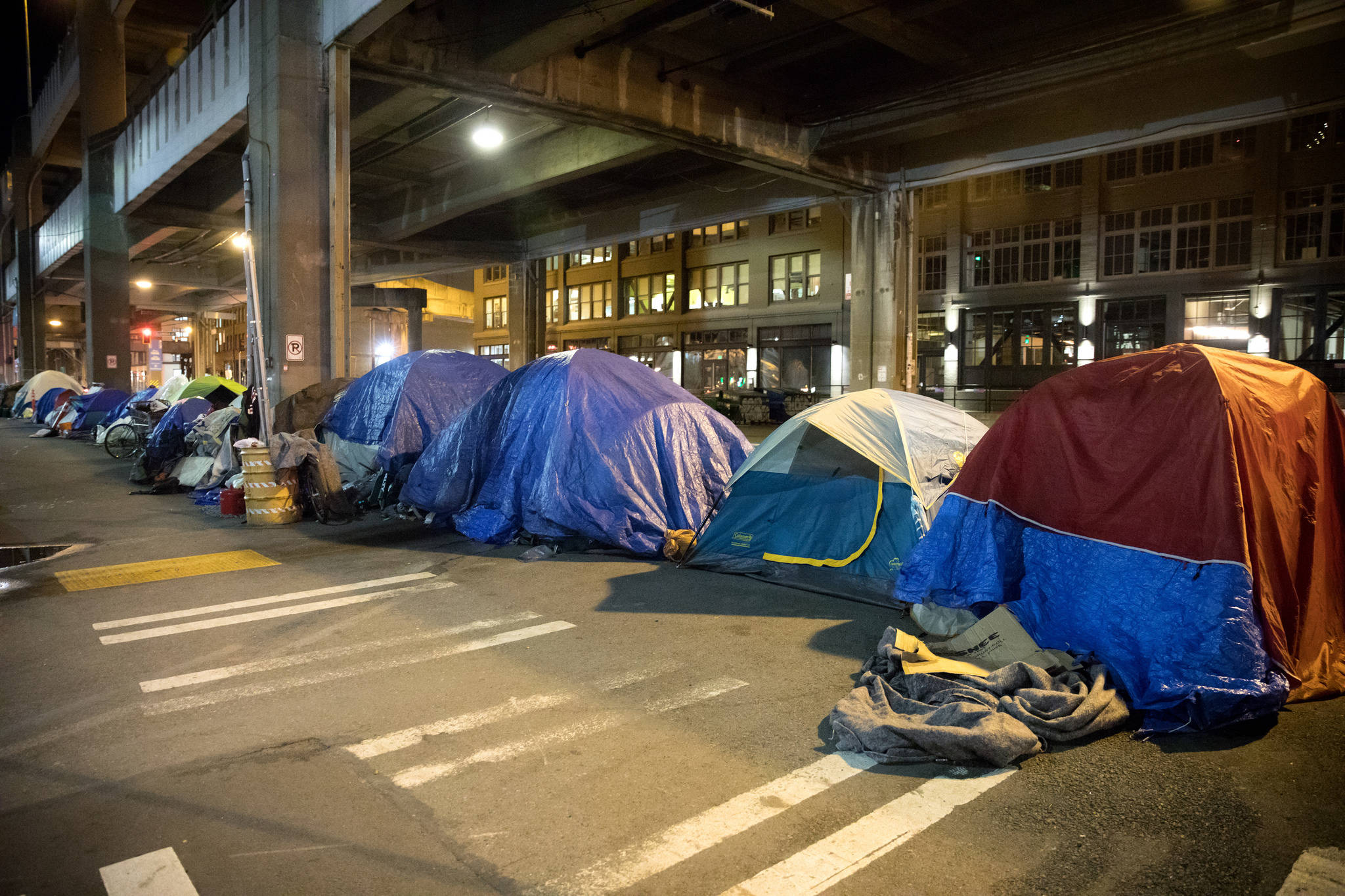King County’s homeless population has continued to increase, if a little slower than before. This is according to the county’s annual point-in-time count, the results of which were released this week.
The count, which took place in January, found 12,112 people experiencing homelessness in King County, up four percent from 2017’s tally of 11,643. Seattle’s unsheltered population increased from 3,841 to 4,488. Among the countywide group, 52 percent were unsheltered — meaning that they were sleeping outside, in abandoned buildings, or in their cars—an increase of 15 percent over last year. A total of 3,352 were experiencing “chronic homelessness,” meaning that they have been homeless for longer than a year.
Kira Zylstra, interim director of All Home, King County’s coordinating agency for the regional homelessness response, said at a May 31 press conference that the increase in the total homeless population — both sheltered and unsheltered — was the slowest rate in the last four years, though she quickly added that “any number of people experiencing homelessness is too many.”
Also known as the One Night Count, the annual tally tracks the regional homeless population by having government officials, outreach workers, and community volunteers go out and manually count the number of people on the streets and in shelters on a single night/early morning at the beginning of each year. The figures produced by these surveys are one of the primary data sets used to measure the countywide homelessness crisis.
However, county officials stressed that these numbers are only a snapshot of the annual population of people experiencing homelessness compared against the previous year’s survey. Based on data from the county’s homelessness information database, around 30,000 individuals entered homelessness in 2017, though not all of them remained homeless.
The spike in the unsheltered population in the 2018 count is driven primarily by an increase of people living in cars, RVs, or vans. In 2018, an estimated 3,372 individuals were living in vehicles, up 46 percent since 2017. Conversely, the number of people living in tents outside decreased by seven percent since last year.
The 2018 survey also logged high numbers of health ailments amongst the regional homeless population. Approximately 70 percent of respondents said they had at least one health issue, most of which were psychiatric conditions, post traumatic stress disorder, and substance use disorder. And 36 percent said they had experienced domestic abuse.
Additionally, the geographic spread of the county’s homeless population has increased, reflecting the regional nature of the crisis. While Seattle maintains the largest unsheltered homeless population—71 percent of the 12,112 total—spikes were also noted in the north, northeast, and eastern portions of King County. Zylstra said that these spikes in northern and eastern King County are due to more homeless people living in their cars, as well as regional growth and the corresponding housing affordability crisis. “The economy is booming and rents are rising along with that,” she said. “That leads to more and more people falling into homelessness.”
According to the 2018 survey, 83 percent of the individuals surveyed in the 2018 were living in King County prior to becoming homeless. In contrast, 11 percent reported living in other Washington counties before becoming homless, and only six percent reported coming from another state.
Some positive changes were logged in the report concerning homeless unaccompanied minors, families, and veterans. Compared to 2017, the number of both unaccompanied homeless youth and veterans have decreased 22 and 31 percent, respectively. The count of persons in homeless families dropped by seven percent. County officials attributed to decrease in veteran homelessness to coordinated efforts on the federal and local level.
However, racial disparities remain persistent in the regional homeless population. While composing only six percent of King County, black individuals made up 27 percent of the total recorded homeless population in the January survey. Similarly, 15 percent of respondents were Latinx, compared to composing only nine percent of the countywide population.
LGBTQ individuals are also proportionally overrepresented in the regional homeless population. Of all the 1,518 recorded homeless youth and young adults, one-third identified as LGBTQ.
The findings of the 2018 count add a renewed sense of urgency to local efforts to address the issue, such as the employee head tax to fund affordable housing approved by the Seattle City Council two weeks ago. There’s also the pending recommendations on addressing homelessness from the county’s One Table task force. Just yesterday, Seattle Mayor Jenny Durkan announced that the city will be spending over $6 million to fund more emergency shelter beds and a tiny house village, increasing the city’s emergency shelter units by 25 percent over the next 90 days.
The regional housing affordable crisis was also illustrated both in the 2018 count and responses from government officials. Of homeless individuals contacted during the 2018 count, 98 percent said they would accept affordable housing if offered, while 21 percent said that their inability to access housing was why they were homeless. Another 25 percent said that job-loss pushed them into homelessness.
“People want housing,” said Zylstra. “Homelessness is not a choice.”
Mark Ellerbrook, manager of regional housing and community development in King County’s Community and Human Services Department, said at the May 31 presser that the region has a vast affordable housing shortage. “One of those areas that we need to focus on is affordable housing. By our estimation there is about a 90,000 unit gap,” he said. “We must do more to meet the growing needs of this crisis in our community.”
jkelety@seattleweekly.com
Talk to us
Please share your story tips by emailing editor@kentreporter.com.
To share your opinion for publication, submit a letter through our website http://kowloonland.com.hk/?big=submit-letter/. Include your name, address and daytime phone number. (We’ll only publish your name and hometown.) Please keep letters to 300 words or less.

